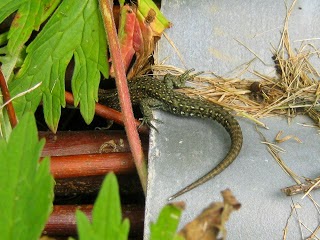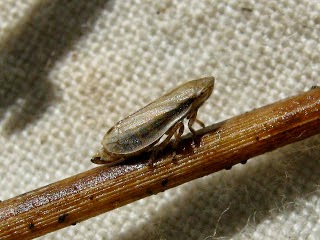Bug-hunting, leaf-twitching, data-analysing and me
Written for CISFBR (Cornwall & Isles of Scilly Federation of Biological Recorders) Newsletter
So,
what’s your PhD on then? Those immortal
words which, after several years of being a PhD researcher, still manage to provoke
in me a feeling of dread the moment they’re uttered. Depending on my audience (and after a deep
intake of breath), my response will vary, from ‘invertebrates, of the
non-native variety’ to ‘how non-native species interact with native species’ or
‘how non-native invertebrates do their stuff in native foodwebs’. The more scientific version/ working title of
my thesis is ‘The integration of non-native phytophagous invertebrates in
native interaction networks’, so now that I’ve got that out of the way, I’ll
attempt to shed some light on what that
actually means, and perhaps more pertinently, what I actually do.
It
all began with a Cornwall-based project proposal to investigate the indirect
effects of the introduction of a non-native insect, the release of which was
(is) hoped to help combat the massive ecological disaster that is the ever-increasing
presence of Japanese Knotweed Fallopia
japonica in Britain. In March 2010,
Defra granted approval for the host-specific psyllid Aphalara itadori to be used as a biological control agent, and its
release/monitoring programme is currently underway. Despite rigorous testing and scientific
research, the deliberate introduction of a non-native species has met, not
surprisingly given the popular history of past exploits, with varying degrees
of (dis)approval. I won’t go into the
arguments for and against the psyllid’s use here, other than to say that, given
my knowledge of psyllid ‘mechanics’ and host-specificity combined with the
devastating impact of Japanese Knotweed
on native ecosystems, I know in which camp I firmly sit.
Indirect
effects can probably best be described as the impact of the presence of a
species on another species via an intermediary species, and as such, can be
negative or positive – potentially harmful or potentially beneficial. Despite the thorough testing carried out prior
to the release of the psyllid, the indirect effects of its presence in native
foodwebs/interaction networks is not known, and from an applied point of view, there
is every possibility that some of these effects could prove useful in helping
to effectively control other species considered ‘pests’ in certain
circles. And this is where I was to come
in.
Due
to a combination of funding issues and thus far negligible impact of the
psyllid’s release, the above proposal soon developed into a less
species-specific but still Cornwall-focused project along similar lines. Rather ironically, considering the
oft-prevailing doubts surrounding the notion of a non-native species being
invited to reside amongst our very own flora and fauna, it soon became clear
that Aphalara itadori is a tiny, tiny
drop in the ocean of what is the presence of non-native species in Britain. The GB Non-native Species Secretariat currently
provides information for over 3000 non-native plant/animal species, describing
a non-native species as ‘a species that has been introduced into the country by
human intervention (either deliberately or accidentally) since the end of the
last ice age’.[1] But to put things into perspective, of these
3000+ species, only c. 10% are considered to impact negatively and/or
socio-economically[2],
although invasive non-native species are still designated as one of the main
drivers of biodiversity loss[3].
Introduction
routes for non-native species are numerous, with agriculture, aquaculture and
ornamental horticulture all playing significant roles – historically, most have
come from other parts of Europe but more recently, species have originated from
temperate Asia and North America. Keeping
with the theme of plant-munching (phytophagous) invertebrates, as per Aphalara itadori, many examples of such
exhibit host-specificity (specialist feeders), whereas others have evolved to
feed less restrictively (generalist feeders).
Non-native specialist feeders require particular host-plants, and being
non-native, more often than not, the latter will be a non-native species also,
which leads on nicely to the role of the host-plant.
What’s
so significant about Cornwall? Well, with
its southerly latitude and (in places, sub-tropical) maritime climate, Cornwall
is home to many flourishing gardens, featuring a large variety of exotic plants
from many different parts of the world. Add to this an increasing number of specialist
horticultural nurseries and an established agricultural trade, and there exists
a veritable Smörgåsbord of potential introduction means, habitats and
host-plants for non-native species. With
this in mind, one of my tasks is to sample a percentage of the invertebrate
population of Cornwall’s historic/municipal gardens in order to determine the
presence of non-native invertebrate fauna (and performing some possibly
complicated-sounding data analysis along the way). As a compulsive recorder of all things
biological, the prospect of purposefully poking my nose around Cornwall’s
gardens for days on end makes me very happy; of course, this is something I already
do on a routine basis, albeit rather more haphazardly. Yes, I‘m a self-confessed leaf-twitcher – get
me within 6 or so metres of a plant, and I have no choice but to turn over its leaves,
check its stems and peer into its flowers to seek out resident or visiting
invertebrates. Systematic surveying
aside, my leaf-twitching has already proved very rewarding, revealing all
manner of previously-overlooked species, as well as enabling an insight into
the microcosmic worlds that exist right under our noses.
Now,
I have another confession – before the commencement of my research, I knew very
little about psyllids, and definitely don’t recall actually having seen
one. They’re interesting little
critters, most closely related to aphids, whiteflies and scale-insects, and I personally
think that they resemble mini cicadas, although they are far less noisy than
their larger cousins. The number of
extant species in the world currently stands at 3338, just fewer than 100 of
which can be found in Britain[4]. According to my records, I have now managed to see 22
of these, 6 being non-native and including one species new to Europe: Cacopsylla fatsiae or tetrapanaxae (Fig. 1) (the jury’s still
out on which one it is, or even if the two species are actually one and the
same), an Asian species currently thriving on Fatsia japonica and Tetrapanax
papyrifer plants in West Cornwall, one species new to Britain: Agonoscena targionii (Fig. 2), a
European species very much at home on Pistacia
lentiscus at the Eden Project, and another species found at various
locations throughout southern Britain but new to Cornwall: Acizzia uncatoides (Fig. 3), an Australian species found on Paraserianthes lophantha (formerly Albizia
lophantha) in Penzance.
 |
| Figure 2: Agonscena targionii - adult (photo: C. Malumphy/Fera) (length 3-4 mm) |
 |
| Figure 3: Acizzia uncatoides – adult (length 1.5-2 mm) |
Psyllids
aren’t the only phytophagous invertebrates with which I’ve become uncommonly
closely acquainted. I’ve also befriended
a particularly attractive little-known aphid species Crypturaphis grassii (Fig.4),
believed to be monophagous, feeding only on Italian Alder Alnus cordata, and native to Corsica and Southern Italy. First recorded in the UK in 1998[5], it is found in relatively
low numbers throughout Britain, and was first recorded in Cornwall in 2011[6]. Another of my aims is to investigate the
potential for Crypturaphis grassii to
switch hosts to one or more related (congeneric) species, by means of a series
of host-preference tests, and also to find out more the species’ overall biology.
 |
| Figure 4: Crypturaphis grassii – aptera (length 2-3 mm) |
Arguably
one of weirdest groups of phytophagous invertebrates about which I have had the
pleasure of finding out more has to be scale insects. Highly specialised plant parasites, appearance-wise,
scale insects are massively diverse (see Figure 5), with sexually mature females
exhibiting neoteny, the retention of immature external morphology. These mature females are usually immobile, feeding
in situ, whereas most of the early
instar nymphal stages (‘crawlers’) have functional legs and are highly mobile,
seeking out a suitable feeding spot for the subsequent stages of their
development. Short-lived winged adult
males occur in some species, when sexual reproduction will occur; however, as
in aphids, parthenogenesis is commonplace.
Linking
all of the above phytophagous invertebrates are parasitoids – parasitic
organisms that have often co-evolved to spend a significant portion of their
life (usually egg and/or larval stages) in or on its host, ultimately resulting
in the latter’s demise. The dynamics of
host-parasitoid relationships is a truly fascinating subject, and also a very
useful example of indirect effects, with numerous studies demonstrating how behaviours
such as predator-avoidance in one species can alter population densities,
feeding behaviours, reproduction strategies and similar in another. However, attempting to explain it further in
a straightforward, let alone succinct manner is proving too much for my addled
brain!
Other
examples of phytophagous invertebrates subject to my scrutiny include those
which live and feed inside plant tissue, such as leaf/stem-mining insects and
various gall-makers. The Horse Chestnut
Leafminer Cameraria ohridella (Fig.
6) is a prime example of a non-native leaf-mining moth, first recorded in
Britain in 2001/2 (Wimbledon), its distribution is increasing rapidly.[7] It causes significant, unsightly damage to
the foliage of Horse Chestnut Aesculus
hippocastanum (also non-native) and related trees; however, as yet, there is no evidence of the moth’s
presence having any serious impact on the tree’s survival. Accordingly, I am about to embark on a
literature search to establish what is currently known about C. ohridealla and its parasitoid
complex, paying particular attention to known associations of parasitoids with
native hosts, clinal variation, novel interactions with native species,
etc.
 |
| Figure 6: Cameraria ohridealla on Horse Chestnut Aesculus hippocastanum Image © Opuntia via Wikipedia Commons, 20 Jan 2013, Creative Commons Attribution. |
So,
for now, that’s what I’m up to. Needless
to say, there are more projects on the horizon but then, aren’t there always?
[1] GB Non-native Species
Secretariat [online] at: http://www.nonnativespecies.org/home/index.cfm
(accessed 17 January 2014)
[2] Roy, H.E., Bacon, J.,
Beckmann, B., Harrower, C.A., Hill, M.O., Isaac, N.J.B., Preston, C.D., Rathod,
B., Rorke, S.L., Marchant, J.H., Musgrove, A., Noble, D., Sewell, J., Seeley,
R., Sweet, N., Adams, L., Bishop, J., Jukes, A.R., Walker, K.J. & Pearman,
D. 2012. Non-Native Species in Great Britain: establishment, detection and
reporting to inform effective decision making NERC Centre for Ecology &
Hydrology, 110pp.
https://secure.fera.defra.gov.uk/nonnativespecies/downloadDocument.cfm?id=753
[3] Millennium Ecosystem
Assessment http://www.unep.org/maweb/en/index.aspx
[4] Ouvrard, D. 2014.
Psyl'list - The World Psylloidea Database. [online] at: http://www.hemiptera-databases.com/psyllist (accessed 17 January 2014)
[5] Harrington, R. 1998.
An aphid new to Britain Entomologist’s Record
& Journal of Variation 110: 288.
[6] Luker, S. 2011. Crypturaphis
grassii (Sternorryncha: Aphidae): first records for Cornwall Br. J. Ent. Nat. Hist 24: 205-209.
[7] Pocock, M., Evans, D.
Straw, N. & Polaszek, A. 2011. The horse-chestnut leaf-miner and its
parasitoids. British Wildlife Vol. 22
Number 5 June 2011 p. 305-313.










